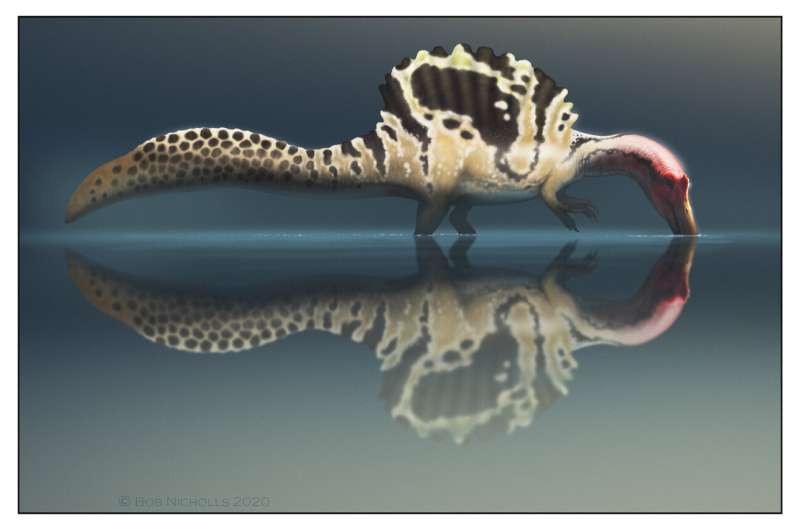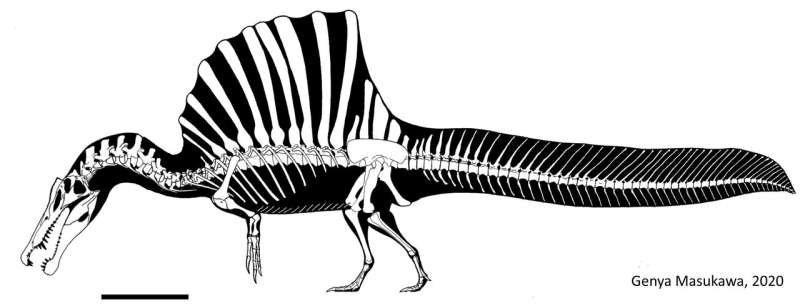Study sheds new light on the behaviour of the giant carnivorous dinosaur Spinosaurus

New research from Queen Mary University of London and the University of Maryland, has reignited the debate around the behavior of the giant dinosaur Spinosaurus.
Since its discovery in 1915, the biology and behavior of the enormous Spinosaurus has puzzled paleontologists worldwide. It was recently argued that the dinosaur was largely an aquatic predator, using its large tail to swim and actively pursue fish in the water.
The new study, published today in Palaeontologia Electronica, challenges this recent view of Spinosaurus suggesting that whilst it likely fed from the water, and may have swum, it wasn't well adapted to the life of an aquatic pursuit predator. Instead it was like a giant (if flightless) heron or stork—snatching at fish from the shoreline while also taking any other small available prey on land or in water.
The researchers compared the features of Spinosaurus with the skulls and skeletons of other dinosaurs and various living and extinct reptiles that lived on land, in the water or did both. They found that whilst there were several pieces of evidence that contradicted the aquatic pursuit predator concept, none contradicted the wading heron-like model, and various lines of evidence actively supported it.
Dr. David Hone, Senior Lecturer at Queen Mary and lead author on the project said: "The biology and ecology of Spinosaurus has been troubling paleontologists for decades. Some recent studies have suggested that it was actively chasing fish in water but while they could swim, they would not have been fast or efficient enough to do this effectively. Our findings suggest that the wading idea is much better supported, even if it is slightly less exciting."

Co-author Tom Holtz, Principal Lecturer in Vertebrae Paleontology, University of Maryland, said: "Spinosaurus was a bizarre animal even by dinosaur standards, and unlike anything alive today, so trying to understand its ecology will always be difficult. We sought to use what evidence we have to best approximate its way of life. And what we found did not match the attributes one would expect in an aquatic pursuit predator in the manner of an otter, sea lion, or short-necked plesiosaur."
One of the key pieces of evidence unearthed by the researchers related to the dinosaur's ability to swim. Spinosaurus was already shown to be a less efficient swimmer than a crocodile, but also has fewer tail muscles than a crocodile, and due to its size would have a lot more drag in the water.
Dr. Hone said: "Crocodiles are excellent in water compared to land animals, but are not that specialized for aquatic life and are not able to actively chase after fish. If Spinosaurus had fewer muscles on the tail, less efficiency and more drag then it's hard to see how these dinosaurs could be chasing fish in a way that crocodiles cannot."
Dr. Holtz added: "We certainly add that the evidence points to Spinosaurus feeding partly, even mostly, in the water, probably more so than any other large dinosaur. But that is a different claim than it being a rapid swimmer chasing after aquatic prey." Though as Dr. Hone concludes: "Whilst our study provides us with a clearer picture of the ecology and behavior of Spinosaurus, there are still many outstanding questions and details to examine for future study and we must continue to review our ideas as we accumulate further evidence and data on these unique dinosaurs. This won't be the last word on the biology of these amazing animals."
Originally found in Egypt, Spinosaurus is thought to be one of the largest carnivorous dinosaurs to exist probably reaching over 15 m in length. The first known Spinosaurus fossils were destroyed by Allied bombing during World War II, which has hampered paleontologist's attempts to understand these unusual creatures. More recently the dinosaur found fame in the 2001 film Jurassic Park III, where it battles and defeats a Tyrannosaurus rex.
More information: David Hone et al. Evaluating the ecology of Spinosaurus: shoreline generalist or aquatic pursuit specialist?, Palaeontologia Electronica (2021). DOI: 10.26879/1110
Journal information: Palaeontologia electronica
Provided by Queen Mary, University of London





















